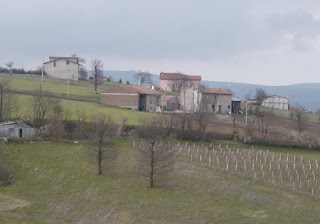Each time I visit my ancestors' hometowns in Italy, I get a bit more adventurous.
Trip #1
 |
| Trip #1 to Grandpa's hometown. |
While staying at a cliffside hotel in Sorrento, home of limoncello, we took a day trip to the city of Benevento. Benevento is the province where every one of my ancestors (save one) came from.
We arrived in Benevento without a real plan. But we found out we could take a bus to my grandfather's hometown of Colle Sannita. So we hopped on.
During the ride, we learned the last bus back to the Benevento train station was leaving 45 minutes after our arrival. The bus was filled with college students who were all trying to be helpful. Some suggested we stay in the beautiful hotel in Colle Sannita called Ca' del Ré.
But all our stuff was in the hotel in Sorrento. So we resigned ourselves to a quick walk through town, and we headed back to the bus. We missed that bus because we got trapped in a bank that was in the midst of a power outage. I've written that improbable tale elsewhere.
The bottom line is, I got only a taste of my roots.
Trip #2
Two years later we planned a second trip to Italy. I'd made contact with a cousin in New York whose sisters still lived in Grandpa's hometown of Colle Sannita. We worked out the details so they were expecting my arrival.
 |
| Trip #2 to where Grandpa actually lived. |
The last person we visited that night was my grandfather's first cousin Libera. She wanted me to visit her daughter and two grandchildren the next day. Each one owned a restaurant in the city of Benevento. We met them and spent another entire day being treated with love and generosity.
That's the dream, right? To go to your ancestor's hometown, meet all the relatives, share stories and feel like you belong to the family. It was heaven.
Trip #3
 |
| Trip #3, soaking in Grandpa's hometown |
We visited my cousins with the restaurants again and had a lovely time. We visited my cousin's home and talked about their grandparents—my great grandparents. We walked through the heart of town. The very same streets I'd looked at on Google Street View time and time again came to life beneath my feet.
Now, on the third try, I've seen it. I've gotten a glimpse of my life if my grandfathers and half of my great grandparents hadn't come to America.
You know what? I liked what I saw.
I wouldn't have the same career, maintaining corporate websites from home with my high-speed internet connection. But I would be there among ancient Roman relics, homes that dated back hundreds of years, and a breathtaking countryside.
If you can make the journey to any of your ancestors' hometowns in the "old country", be sure to slow down. Walk through the center of town and observe the people. Say hello to them. You may find they're more friendly and courteous to strangers than you're used to at home.
I'm already thinking about what trip #4 might be like. My goal? To stay longer. To live there for two or three months at a time. To become a familiar face in the piazza. To honor my ancestors.




